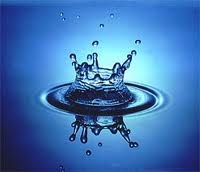I saw a commercial today for the famous Irish beer, Guinness. This beer has a very unusual fluid property, the bubbles on the top of the beer sink. This is due to the flow of the bubbles from the bottom of the beer to the top of the beer. Due to the shear from the side of the glass, the bubbles on the outside are slowed and eventually begin to sink. In the center of the beer the bubbles are rising, you just can't see them. This creates a parabolic velocity profile and gives off the appearance that the bubbles in Guinness beer sink.
This blog was an assignment for my chemical engineering fluid mechanics course at Auburn University. The posts are about naturally occurring fluid mechanics phenomena that I noticed on a daily basis.
Wednesday, August 31, 2011
Tuesday, August 30, 2011
Special Characteristics of Water
Today, in my thermodynamics class I was aware of the special fluid mechanics of water while looking at a phase diagram. Density is an important topic in fluid mechanics and water demonstrates one of the most unusual behaviors in reference to density. Water expands upon freezing (i.e. solid water is less dense than liquid water). This is the reason ice floats.
 |
| Phase diagram of water. |
The negative slope of the line starting at the triple point and proceeding between the ice and water regions shows that water expands upon freezing. This fluid mechanic property of water is important for several reasons. If ice was more dense than water all the lakes and oceans would freeze from the bottom to the top, killing all biology and creating solid oceans and lakes. Because ice is less dense and floats, it insulates the water underneath to prevent complete freezing from occurring.
Friday, August 26, 2011
In the Begining
I'm a chemical engineering student at Auburn University and I am creating this blog for a class project. The purpose of this blog is to take my formal learning of fluid mechanics and write posts about how it affects the way I perceive natural phenomena in day to day activities. So far, we've had one week of class and have talked very little about fluid mechanics. I've watched several videos on the CD included with the textbook and they were very helpful in giving me a basic vocabulary to be able to describe fluid behavior. I've had a few technical observations that I've made recently but I can't remember their specifics. So, I’m going to describe this elementary picture for today's post.
To most this is just a drop of water falling into a pool of water. To the chemical engineer this image holds much more value. The relatively high surface tension of water causes the small water droplets that are the farthest from the surface to form spheres. Surface tension is the ability of a surface of a liquid to resist external forces. There is a certain energy and momentum that is associated with the falling droplet. It is this momentum and energy that governs the height of the resulting splash.
Subscribe to:
Comments (Atom)

